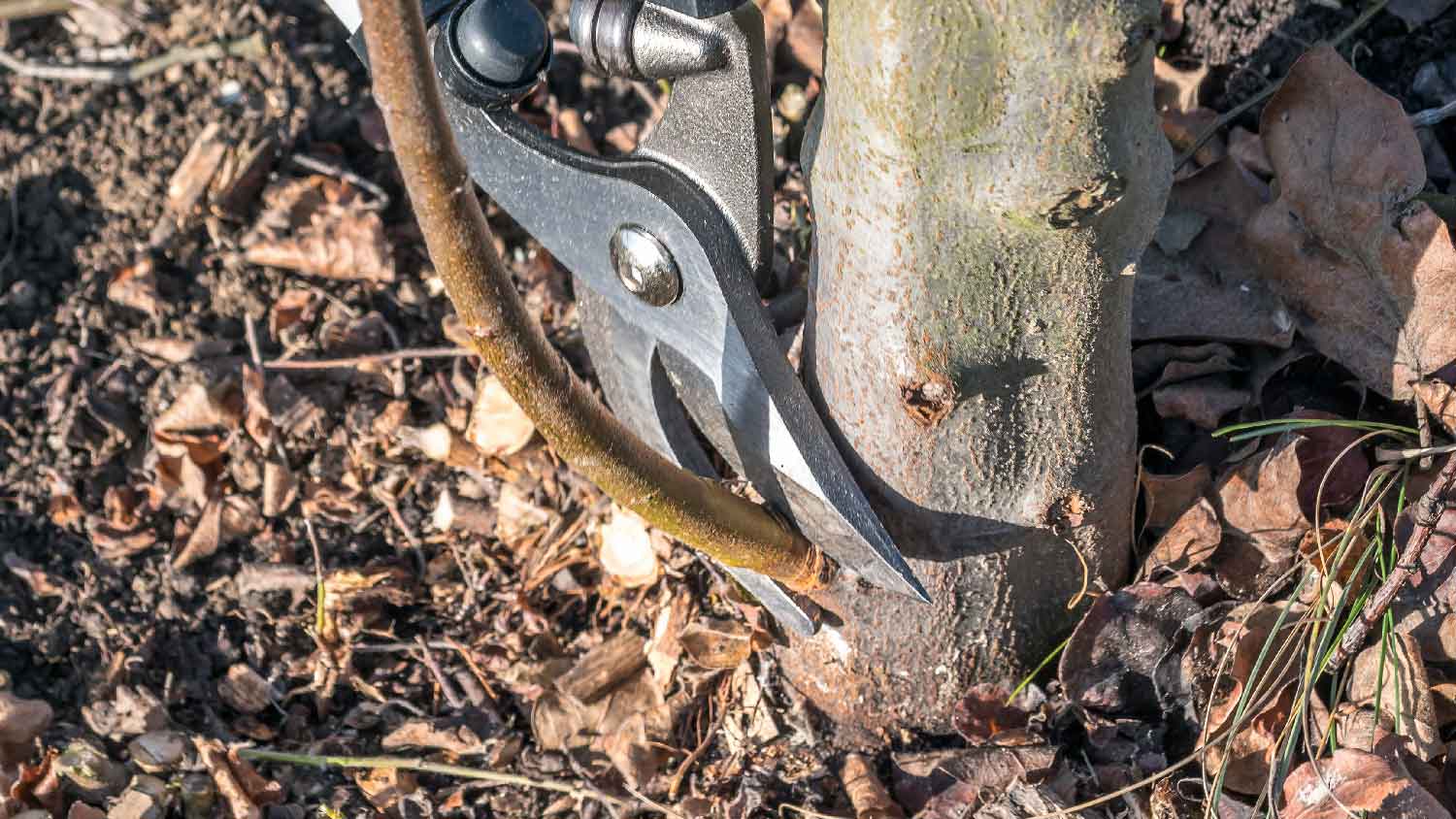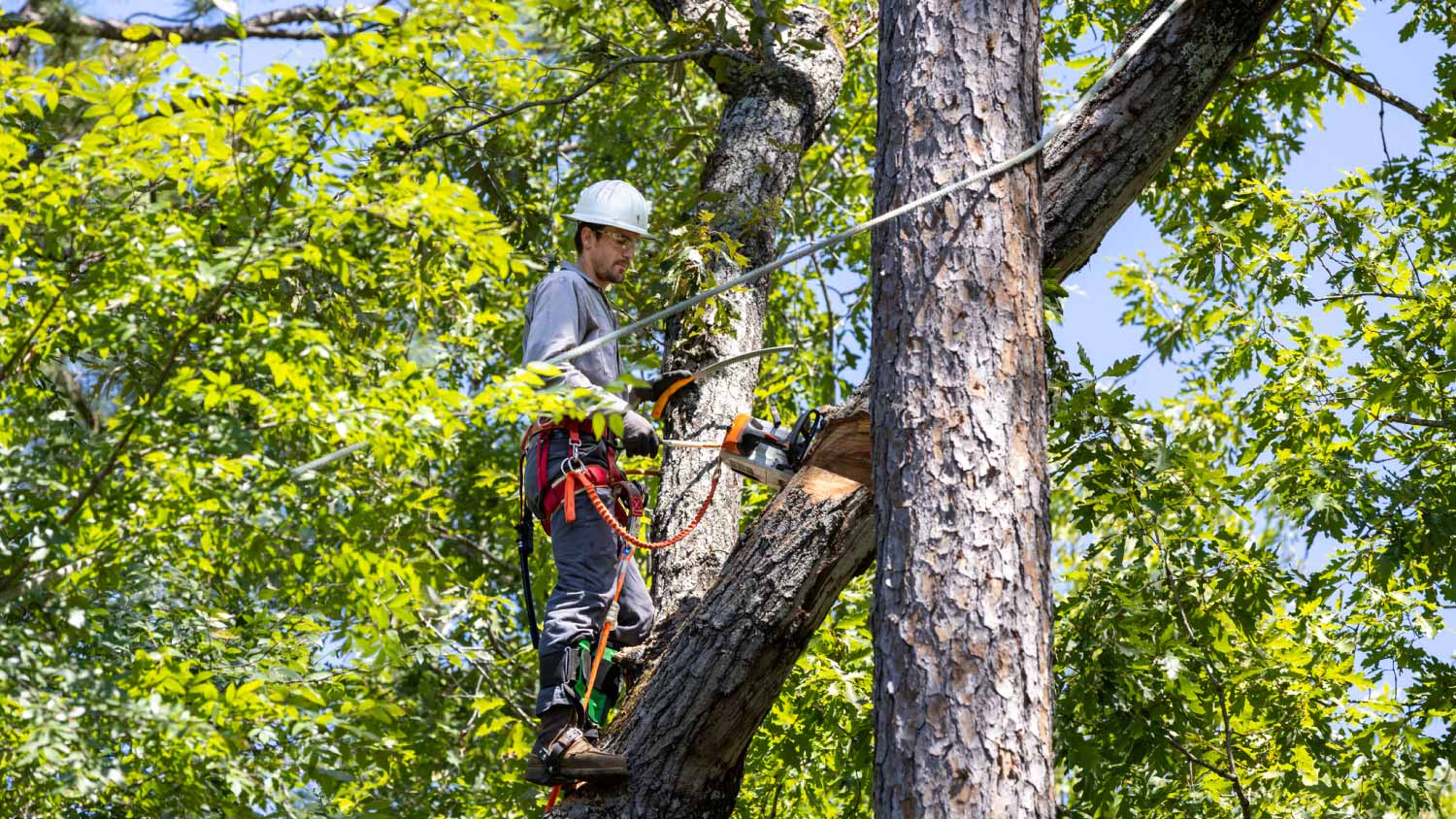
Tree inspections can ensure your trees stay healthy and safe, preventing costly damage. Learn how much tree inspections cost and what can affect the price.
Get rid of suckers so your tree can thrive with these simple tips


Tree suckers steal nutrients from a tree and should be removed early to reduce stress on the tree.
Over-pruning or cutting too close to the trunk can cause more suckers.
Hiring an arborist or other landscaping pro for pruning and treatments starts at $75 and can reduce sucker regrowth and keep trees healthy.
Tree suckers can be a sign of disease; hire a licensed tree removal expert to evaluate large trees with persistent suckers to make sure they’re safe and stable.
If your tree is stressed after being transplanted or grafted, tree suckers may grow from the roots where the base tree is vying for dominance. It’s important to learn how to get rid of tree sucks because these branches can be annoying and unhealthy for the tree. Whether you want to tackle the tree suckers yourself or enlist the help of a tree removal pro, here’s what you can do to deal with tree suckers.
Tree suckers are an attempt by a tree to grow new branches from the roots of the tree. These suckers can form because of over pruning, drought shock, overshading, or other kinds of stress from tree disease or pest infestation. The problem with suckers is that they often don’t grow the same way that your tree grows, and they can steal nutrients from healthier branches that the tree needs.
Suckers aren’t good for the tree, but pruning can be a source of stress for trees, causing the conundrum of stressing the tree by pruning, and thus stimulating the growth of more suckers. To prevent this paradox, you should trim suckers as young as possible when it’s the least stressful for the tree.
Tree suckers are easy to spot once they’ve sprouted. They’ll appear as long, straight shoots that protrude from the root base of a tree. Rather than growing out from the trunk like regular branches, tree suckers will grow straight up from a tree’s roots or base or exposed roots of a tree, growing leaves mostly at the tip of a long, straight branch. If you notice new growth coming from the tree’s roots or the base, you can nip it in the bud before it sprouts leaves by rubbing the shoot off of the main root it’s growing from.

Getting rid of tree suckers can be tricky. Since they often occur because a tree is stressed, cutting them back the right way is important to avoid stimulating the growth of more suckers. Here are some ways to get rid of suckers and tips to keep in mind for a successful extraction.
If a tree sucker is growing from the root of your tree, tearing it away from the root rather than clipping it with shears can help stop its growth and avoid regrowth later. While wearing protective gloves, use your hands to pull away soil from where the sucker is growing and tear off the sucker below its base. Then, cover the root back over with about three to four inches of soil.
If you have suckers that are growing from the root stock of a grafted tree or the trunk, you should prune the sucker close to the base, leaving the nub that forms when it sprouts to encourage healing. Similar to pruning trees, you should use tools like pruning shears, loppers, and pruning saws for this removal method. You should use heavy-duty tools like pruning saws for very thick tree suckers, as they can remove ones up to five inches thick.
Since suckers are usually caused by stress, watering well after pruning them away can help the tree recover and prevent the growth of new suckers. Making sure that shallow roots get lots of access to water while the tree is healing will decrease the likelihood of causing more suckers to sprout. Once the suckers have been trimmed off, soaking the soil to a depth of six to eight inches with a sprinkler should be sufficient.

Suckers are caused by stress to the tree, so reducing stress, giving the tree lots of water, and avoiding over pruning is the best way to prevent suckers from sprouting in the first place. Watering the roots of your tree when it’s especially hot and dry can also help your tree avoid suckers.
To prevent over pruning your stressed tree, follow the ⅓ rule: Don’t prune more than ⅓ of the height of a tree or a third of the total size of a tree. You should also only prune during the more hospitable times of the year, either in spring after flowers drop off the tree or in early autumn before temperatures are regularly below freezing. This pruning schedule will help you avoid stressing the tree and causing suckers to form.
While you can usually DIY removing tree suckers, if you have a problem with returning suckers that keep coming back, suckers that matured and turned into larger branches, or suckers that might be an indication of major damage to the tree from infection or infestation, hiring a local tree removal pro is prudent.
Since larger trees can cause risks to structures or even people if they are unstable, a larger, damaged tree should be assessed by a tree removal pro to make sure it’s safe. The cost of hiring a professional to prune tree suckers is $75 to $1,500, depending on the tree type, number of tree suckers, and number of trees.
From average costs to expert advice, get all the answers you need to get your job done.

Tree inspections can ensure your trees stay healthy and safe, preventing costly damage. Learn how much tree inspections cost and what can affect the price.

Get a clear estimate of palm tree maintenance cost, including trimming, fertilization, and pest control, so you can keep your palms healthy and your budget on track.

Discover the average tree maintenance cost, key price factors, and tips to save. Get expert insights to plan your tree care budget with confidence.

What is an arborist and do they cut down trees? Learn what an arborist is, the services they offer, and when to hire one.

Grinding a tree stump requires a chainsaw, heavy-duty equipment, and a strategy for cleaning up debris. Keep reading to learn how to use a stump grinder.

What’s the best tree stump killer? Learn how to kill a tree stump using these seven effective methods.